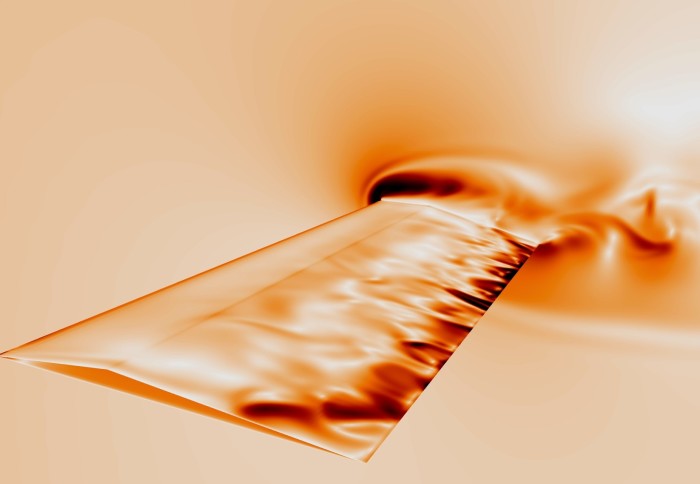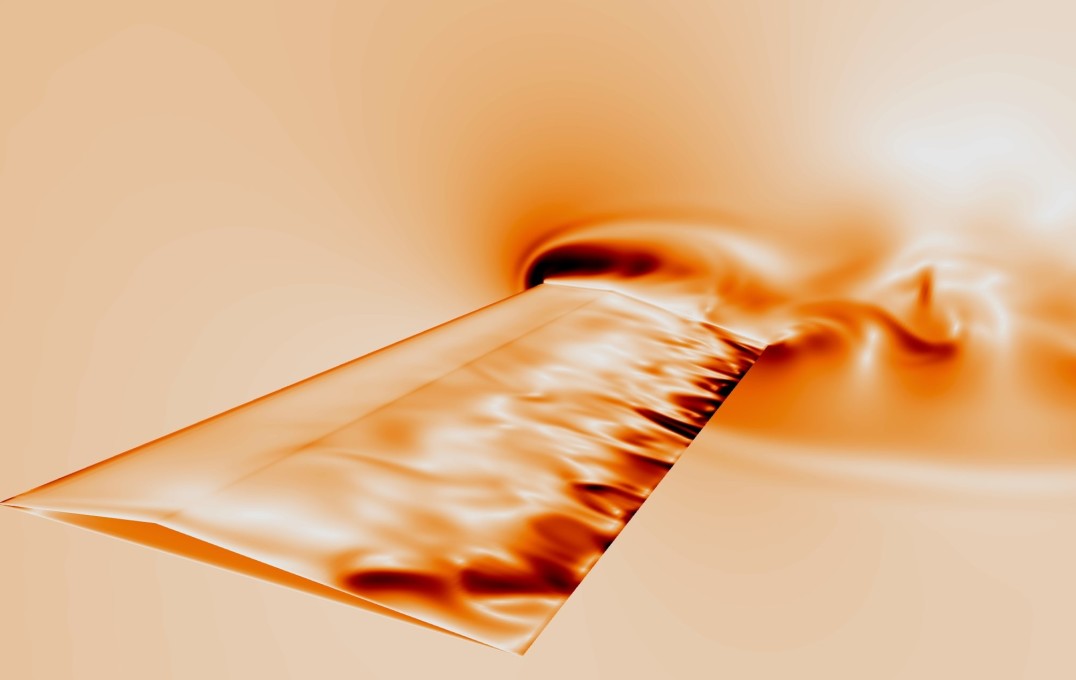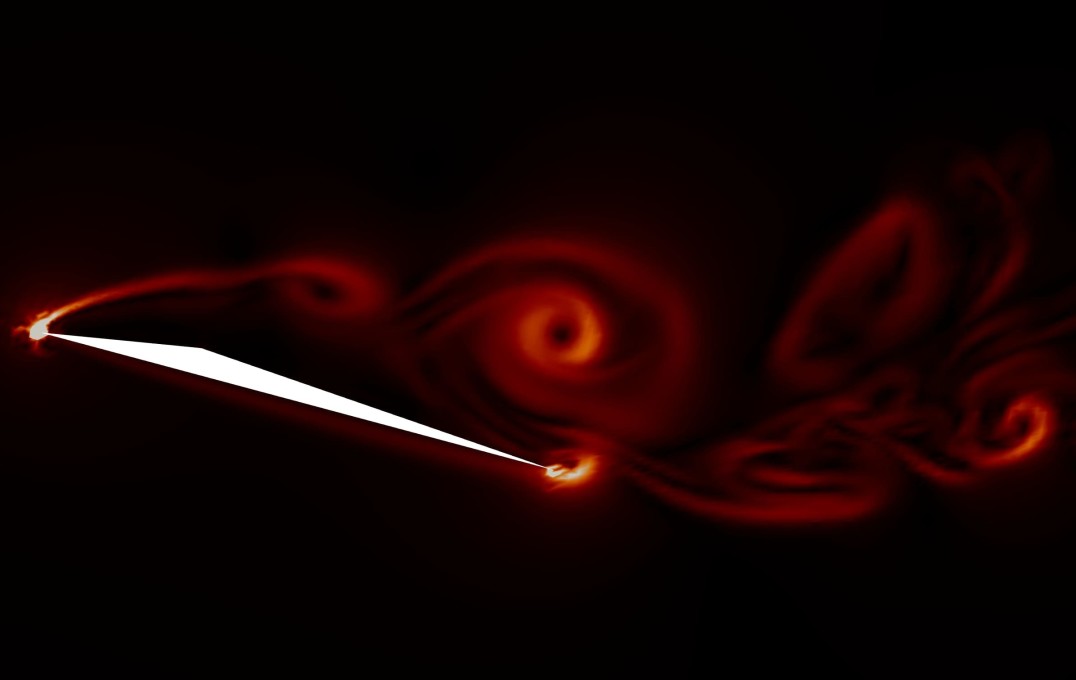Unique ‘virtual wind tunnel’ could help optimise Mars-bound helicopter blades
by Jacklin Kwan

A simulator created by researchers at Imperial could help to design rotor blades for the next generation of Martian helicopters.
Following the recent success of NASA’s Ingenuity Mars Helicopter, which demonstrated that flight on Mars is technically possible, engineers are seeking new ways to create even better optimised helicopters that can fly longer distances at higher altitudes, with heavier payloads.
Our simulator will help to design fundamentally new blades that will perform efficiently on Mars. Lidia Carós Roca Department of Aeronautics
Though they are considered planetary siblings, Earth and Mars' atmospheres are radically different, with Mars' atmosphere being around 100 times thinner than Earth's. This presents scientists with unique challenges in designing helicopters that can generate enough lift to take off in “air” that is less dense with higher wind speeds.
Now, engineers at Imperial have created a ‘virtual wind tunnel’ simulator that recreates Mars’ atmospheric conditions to test helicopter blade designs. By comparing their results with those from the real-life Mars Wind Tunnel in Tohoku University, Japan, they found that their simulations recreated true Martian conditions with a much higher degree of accuracy than has previously been possible.
Lidia Carós Roca, a PhD student from the Department of Aeronautics who was lead author of the group’s research paper, said: “The Martian atmosphere has a very low density – the air is as thin as the Earth’s atmosphere at very high altitudes.
“Conventional blades have benefited from over 100 years of aeronautical design experience. However, the low density and low speed of sound on Mars presents a flight regime unlike anything encountered on Earth, making such blades inefficient for Martian flight. Our simulator will help to design fundamentally new blades that will perform efficiently on Mars.”
Three dimensions
The atmosphere on Mars is less dense than on Earth, and the speed of sound is slower. This unusual combination means that simple modelling strategies do not yield accurate results. Instead, the Imperial team used their own, in-house high-fidelity solver, called PyFR, to directly simulate the governing equations of motion on Mars.
They ran the simulations on some of the world’s largest supercomputers, including EPCC’s Cirrus in Edinburgh and Piz Daint at the Swiss National Supercomputing Centre. In particular, the Imperial team exploited computer
(Wind tunnel walls) can fundamentally affect the nature of the flow over the blade in a wind tunnel and affect our understanding of the blade’s performance. Dr Oliver Buxton Department of Aeronautics
graphics cards, initially designed for use in computer gaming, to make such complex simulations possible.
Previous attempts to simulate the experiments at Tohoku University were less successful when the blades were mounted at a high angle-of-attack, which refers to the angle between the blade and the oncoming flow.
Study co-author Dr Oliver Buxton of the Department of Aeronautics said: “Whilst wind tunnel experiments are usually considered the gold standard, they are not without their issues. For example, blades must be mounted in close proximity to the tunnel walls. These walls simply do not exist for a real helicopter blade, yet they can fundamentally affect the nature of the flow over the blade in a wind tunnel and affect our understanding of the blade’s performance.”
Our simulations have proven to be extremely accurate in predicting the lift and drag of these Martian helicopter blades. Professor Peter Vincent Department of Aeronautics
The research team gradually increased the realism of their simulations and showed that only when the full span of the blade plus the wind tunnel walls were fully simulated did the results come close to the Tohoku experiments. Further, their simulations were able to predict a key change in the behaviour of the blade with angle-of-attack. At a particular incidence the lift mechanism of the blade changes suddenly with the formation of a large vortex that acts to suck on the top surface of the blade, thereby increasing its lift.
Study co-author Professor Peter Vincent, also from the Department of Aeronautics, said: “Our simulations have proven to be extremely accurate in predicting the lift and drag of these Martian helicopter blades. The fact that we are even able to predict these big and sudden changes in lift performance gives us great confidence that the tools we have developed will enable us to design more efficient Martian helicopter blades in the future.”
This new knowledge could help engineers to increase the performance of aerofoils on both Earth and Mars. The next step for the researchers will be to use their simulator to test specific aerofoil shapes. With further development, the rotor blades optimised by the Imperial team may one day be flying across the rocky terrains of our neighbouring red planet.
“Direct Numerical Simulation of flow over a Triangular Airfoil under Martian Atmospheric Conditions” by L. Caros, O.R.H. Buxton, T. Shigeta, T. Nagata, T. Nonomura, K. Asai, and P.E. Vincent. Published [date] in AIAA Journal.
Images and GIFs: Lidia Carós Roca
Image/GIF 1: Shear forces acting on the airfoil and the wind tunnel walls. The unsteady nature of the flow is apparent.
GIF 2: Vortices generated by the triangular airfoil. The unsteady nature of the flow is apparent.
GIF 3: Density gradient near the airfoil surface and in the wake behind the airfoil. The unsteady nature of the flow is apparent.
Article text (excluding photos or graphics) © Imperial College London.
Photos and graphics subject to third party copyright used with permission or © Imperial College London.
Reporter
Jacklin Kwan
Faculty of Natural Sciences


